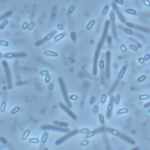Lien vers Pubmed [PMID] – 29529083
PLoS Pathog. 2018 03;14(3):e1006940
Clostridium difficile is the primary cause of nosocomial diarrhea and pseudomembranous colitis. It produces dormant spores, which serve as an infectious vehicle responsible for transmission of the disease and persistence of the organism in the environment. In Bacillus subtilis, the sin locus coding SinR (113 aa) and SinI (57 aa) is responsible for sporulation inhibition. In B. subtilis, SinR mainly acts as a repressor of its target genes to control sporulation, biofilm formation, and autolysis. SinI is an inhibitor of SinR, so their interaction determines whether SinR can inhibit its target gene expression. The C. difficile genome carries two sinR homologs in the operon that we named sinR and sinR’, coding for SinR (112 aa) and SinR’ (105 aa), respectively. In this study, we constructed and characterized sin locus mutants in two different C. difficile strains R20291 and JIR8094, to decipher the locus’s role in C. difficile physiology. Transcriptome analysis of the sinRR’ mutants revealed their pleiotropic roles in controlling several pathways including sporulation, toxin production, and motility in C. difficile. Through various genetic and biochemical experiments, we have shown that SinR can regulate transcription of key regulators in these pathways, which includes sigD, spo0A, and codY. We have found that SinR’ acts as an antagonist to SinR by blocking its repressor activity. Using a hamster model, we have also demonstrated that the sin locus is needed for successful C. difficile infection. This study reveals the sin locus as a central link that connects the gene regulatory networks of sporulation, toxin production, and motility; three key pathways that are important for C. difficile pathogenesis.

